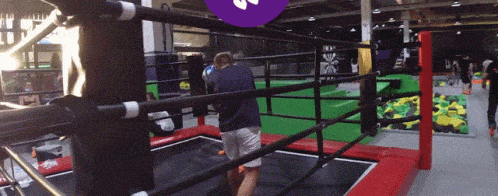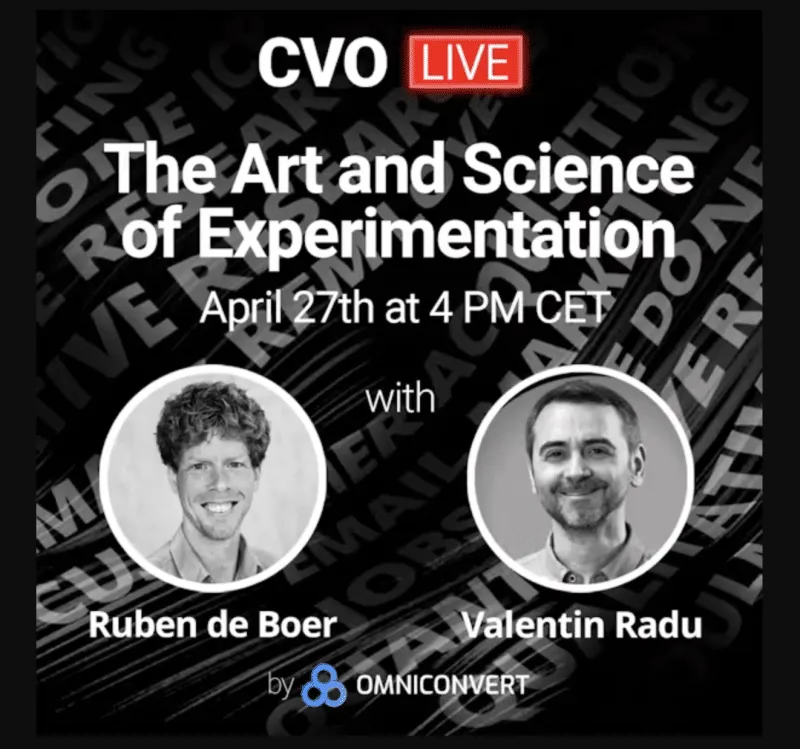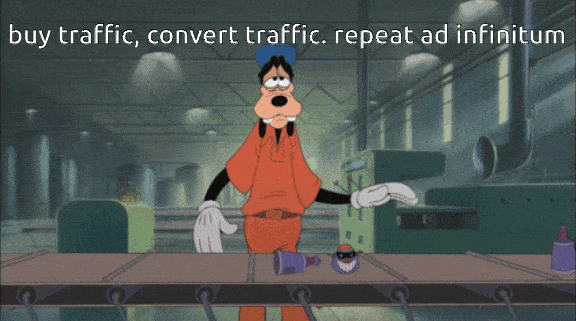During one of our CVO Live episodes, we were joined by Ruben de Boer, to discuss one of the most heated “battles” in the Digital Marketing Arena: acquisition vs retention.
In one corner, weighing 100 pounds of tests and statistics, you have the CRO champions. Focused on research, hypothesizing, and A/B tests, these people think a highly-converting website is a key to business growth.
In the opposite corner, weighing 100 pounds of surveys and JTBDs, you have the CVO heroes.
Focused on the customer, data collection, and objective decisions, CVO people are convinced that a customer-centric approach is a winning bet.
Who will win?

As CVO evangelists, you’ll be inclined to believe that we’re supporting the CVO champion, right?
Well, not quite.
We believe in balance. We believe in the right balance.
To that end, we’ve invited Ruben de Boer to join us for a CVO Live episode and share the CRO professional’s view on Customer Value Optimization.
We were primarily interested in seeing how a CRO strategy fits into the CVO methodology for an eCommerce business.
Ruben is a Conversion Optimization Consultant & Bestselling Instructor as well as the Lead Conversion Manager at Online Dialogue.

What followed was an exciting and eye-opening experience, as he and Valentin Radu discussed the relationship between the CRO process and CVO methodology, overcoming organizational inertia, and the unlikely benefits of a customer-centric approach.
Let’s ride!
A quick glance at Conversion Rate Optimization (CRO) and Customer Value Optimization (CVO)
First things first.
It shouldn’t be a matter of one versus the other. Conversion Rate Optimization and Customer Value Optimization are essential concepts you need to consider in your optimization strategies.
They both revolve around maximizing an online business’s effectiveness and better strategizing to meet customers’ needs and expectations.
CRO and CVO should work together, intertwining themselves around better serving the customer. An effective CRO program increases your conversions and turns site visitors into customers.
However, the job isn’t done as soon as you meet your conversion goals.
It’s similar to losing weight.
Even if you take your weight optimization efforts to new heights while in the fat loss process, if you return to your former lifestyle once you shed the weight, you’ll soon find yourself back on square one.
Losing weight is only the beginning. You should continue with maintenance, healthy food choices, and continuous training for muscle gains.
In eCommerce, increased conversions are only the first step of business growth. What happens after, with retention, matters as much as what happens on Social Media and on your website.
From this perspective, it’s safe to say that CRO is part of the bigger CVO picture.
CRO is about helping potential customers, and website visitors research the desired products, then safely purchase them in a straightforward, intuitive process.
CRO and CVO might have distinct objectives, but they’re still interconnected.
A combination of CRO and CVO will empower businesses to improve conversions while simultaneously maximizing the value derived from each customer.
Focusing on the Entire Lifecycle vs. Focusing on the Website Exclusively
Up until a couple of years, the status quo was that marketing managers were really spending managers. They would measure conversions on the website, then use conversation rate optimization tools to turn more visitors into customers.

The more money invested in bringing the target audience to the website, the more customers will join the brand. This meant spending most of the budget on buying traffic, analyzing visitor behavior to optimize the website, and then changing it to make it more persuasive.
It was a numbers game. The more people on the website, the merrier.
But things change, and more than conversion metrics are needed to measure growth.
Not anymore.
The spike in customer acquisition costs, emerging privacy anxieties, and the vanishing of third-party data forced online brands to explore fresh avenues for business growth.
What’s worse, for some brands, this pursuit became a matter of survival as they faced the reality that existing strategies were no longer sustainable.
In this context, trailblazers and open-minded brands shifted their focus – from optimizing the website in order to increase the conversion rate to a more holistic approach: Customer Value Optimization (CVO).
This change is evident if you analyze the eCommerce briefs received by industry professionals, consultants, and experts.
A few years ago, the primary concern was optimizing conversion rates through A/B testing on landing pages and checkout processes.
However, the paradigm has now expanded, and businesses want to optimize for broader aspects of the customer journey.
eCommerce people seek guidance in optimizing the entire customer experience.
They have questions about personalization, optimization tools, AI integration, and experimentation across the entire sales funnel.
What was once a tiny part of the overall strategy has now evolved into a holistic approach that relies on qualitative data and customer insights to encompass the entire customer lifecycle.
According to Ruben, this shift towards a more comprehensive perspective indicates the industry’s progress.
It signifies a transition from short-term CRO to an ongoing commitment to experimentation throughout the entire customer journey.
This promising development for Ruben underlines the importance of delivering value at every touchpoint and ensuring a fruitful and enduring customer relationship.
CRO and CVO working as a team – no more silos
How will the future look when we stop seeing CRO versus CVo, and see them as two parts of the same story?
Ruben already sees this shift in the digital landscape, believing it’s a “game-changer.”
And we agree.
When we work together instead of in isolated silos, we unlock a treasure trove of insights.
These insights show brands what truly works at each stage of the customer journey throughout the entire lifecycle, combining CRO and CVO tactics to fine-tune the complete optimization process.
However, Ruben warns us there’s a secret sauce to this utopian collaboration – documentation.
Diligently recording all your learnings builds a robust database that unravels the desires and objectives of your customers.
It becomes crystal clear how to optimize every single step in the lifecycle.
The asterisk is that this type of collaboration works only when brands foster teamwork, knowledge sharing, and process alignment inside the organization.
Evidently, this culture isn’t built in one day. For some brands, it might even be an expense they can’t afford – a time-waster, if you will.
However, you’re poised to achieve remarkable results and elevate our collective success inside such a culture.
Like what you're reading?
Join the informed eCommerce crowd!
We will never bug you with irrelevant info.
By clicking the Button, you confirm that you agree with our Terms and Conditions.
Experimentation as a form of Customer Research in CRO
Ruben also mentioned an interesting idea: experimentation is essentially a form of research.
In customer-oriented CRO, experimentation becomes the most critical form of research, uncovering what works and what doesn’t.
In this scenario, you must start the client dialogue with multiple teams and conduct an extensive data and behavior study.
Why?
Picture this: a squad of analysts, data scientists, and a crew of UX designers and researchers teamed up with several psychologists.
Together, they delve into their research sources to uncover the intricacies of what’s happening on the website, how the product is performing, what’s going on even before people land on the site, and most importantly, the customers’ needs.
When you combine a diverse group of specialists with a wide range of research sources, you unlock a treasure chest of insights even before you kickstart your experiments.
And then, throughout the entire journey, as you experiment and analyze the results, you start to validate those research insights, identify emerging patterns, and the whole organization reaps the benefits.
Ruben gives us the example of one of his top clients significantly upgrading their commercial based on the lessons learned from user research and A/B testing in the funnel.
That’s the power of collaboration, strengthening one another through shared knowledge and insights.
Transitioning from a rigid CRO mindset to an Experimentation Mindset
Traditionally, CRO primarily focuses on boosting conversion rates on a website. It’s about optimizing the website experience to increase the likelihood of visitors taking desired actions and becoming customers.
Experimentation, on the other hand, goes beyond CRO and covers a broader spectrum.
When you move beyond the (sometimes) limited CRO tactics and optimize your website from an experimentation mindset, you optimize various aspects of presenting the brand.
You have a more comprehensive approach involving the product itself, referrals, and even advertising efforts to attract more people to your website.
For Ruben, this expansion is fantastic.
It means CRO specialists are no longer confined to their silos.
They’re branching out, collaborating with other teams, and embracing a new challenge: motivating colleagues to adopt a mindset that revolves around:
- Experimentation
- Data-driven decision-making
- Prioritizing customers’ needs.
This opens up exciting opportunities for growth and innovation within organizations.
Fostering a culture of experimentation and embracing a customer-centric perspective empowers businesses to unlock their full potential and thrive.
It’s an exciting journey.
Building a case for switching from product-centricity to customer-centricity
All is good in this wonderful collaborative environment. Yet, only some businesses understand the need to shift.
And it’s not because of rigidity of stubbornness – the bottom line is crucial to all brands, and sometimes there isn’t enough bandwidth to overhaul the entire organization while still earning monthly revenue.
Think about personal goals like losing weight or saving money—achieving them demands a shift in behavior, and many people find it challenging.
It’s essential to approach this transformation as a fun educational challenge and remain mindful, avoiding frustration. It won’t happen overnight, so this journey will require your time and patience.
You may be tempted to convince your colleagues solely with facts and figures.
However, this approach comes off as pushy.
It ignores your colleagues’ interests, KPIs, and ways of working.
Instead, try and be seen as a likable authority. The Gandalf and Dumbledore of the eCommerce space: humble, passionate, and respectful.

Take an interest in your colleagues’ work and strive to align experimentation with their goals rather than imposing your own objectives.
At the same time, as Ruben so wonderfully puts it, it’s not about being against others.
Moving the focus from the product to the customer means multiple teams jumping on the same mission, working towards a common goal.
By approaching this shift with humility, respect, and a genuine interest in your colleagues’ POV, you can reach a collaborative environment where experimentation, customer-centricity, and da,ta-driven practices become the norm.
It’s about building relationships, understanding each other’s motivations, and working together toward shared success.
Overcoming Organizational Inertia for more flexibility
Even if your teammates and stakeholders are open-minded and willing to operate more customer-centric, there’s still a hurdle to pass.
This is a common hurdle in large organizations. The leadership team may be supportive, but middle management and execution teams face inertia.
A.k.a., “We’ve always done it this way.”
Picture this scenario:
You have an enthusiastic internal champion for experimentation, but other departments aren’t as keen.
They need that influence and collaboration to dive into experimentation and customer-centricity.
So, how do we tackle this?

Keep it small and straightforward, avoiding overwhelming people with complex statistics and graphs. Start with a single idea and work together to discuss and implement it.
It’s all about collaborating and motivating different departments and teams.
For the champion and their team, having a structured process is vital.
Like in UX research or CRO, having a regular stand-up meeting to discuss ongoing experiments, research, and responsibilities is beneficial. Allocate the last 10 minutes of these meetings for brainstorming sessions on motivating specific departments or teams.
Share ideas, learn from each other’s experiences, and optimize your approach based on what works and doesn’t.
It is an ongoing journey of education, brainstorming, and optimization leading to growth and innovation.
What should we expect from the Future of CRO?
And the end of the podcast, we switched from the now to the future.
What happens next?
Ruben predicts that the days of CRO specialists working in isolation are numbered.
The CRO silo is on its way out, and these specialists are taking their experimentation mindset and customer-centric approach to join forces with product and marketing teams.
The goal is to optimize the entire customer journey, focusing on experimentation, personalization, and the growing role of AI.
On the marketing front, teams are diving into the entire customer journey.
They are exploring opportunities for experimentation, personalization, and the integration of AI technologies. It’s an exciting ambition that requires preparation and a keen eye for the evolving landscape.
Meanwhile, product teams embrace a continuous discovery track, conduct user research, and continuously validate ideas and assumptions. Experimentation plays a vital role here and in the product delivery phase, where engineering pipelines become hubs for experimentation.
These trends are gaining momentum in mature markets from the United States, the UK, the Netherlands, and Germany.
It’s clear that we’re entering an exciting era of change.
This brings us to AI and its applications in the experimentation space.
Based on his experience, Ruben sees a dual impact on AI.
Firstly, it will power personalized messaging, landing pages, ads, and touchpoints, allowing for a highly tailored customer experience.
Secondly, AI can enhance the work, automating tasks like analyzing reviews, surveys, and code building. Although it’s not fully realized yet, AI’s role in making our work more efficient will continue to grow.
These developments mark a significant shift in how we approach experimentation and optimization.
Embracing the power of collaboration, personalization, and AI-driven efficiencies, unlocks new levels of success. At the same time, it delivers exceptional experiences for your customers.
It’s an exciting journey that promises to shape the future of experimentation.
Wrap Up
That’s how it should be—working together, learning together, and propelling each other toward success.
An important disclaimer: our purpose isn’t to persuade you to stop your CRO efforts altogether. By all means, you should continue calculating the conversion rate and optimizing your website through experimentation.
Our scope is to help you understand that increasing the percentage of your website conversion is only the beginning.
Retention matters. Maybe now, more than ever.
We’d like to thank Ruben for being an absolute star and bringing his insights to the world. It was a blast!
You can find his LinkedIn profile here. And if you want to hear the whole episode, click here.
Happy converting!